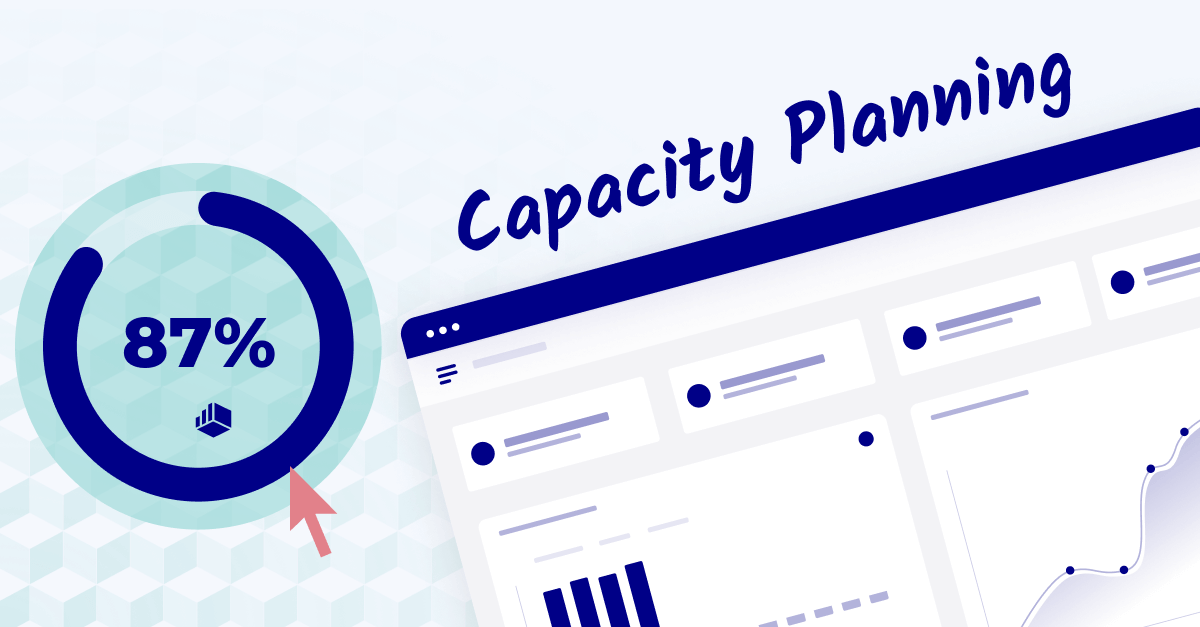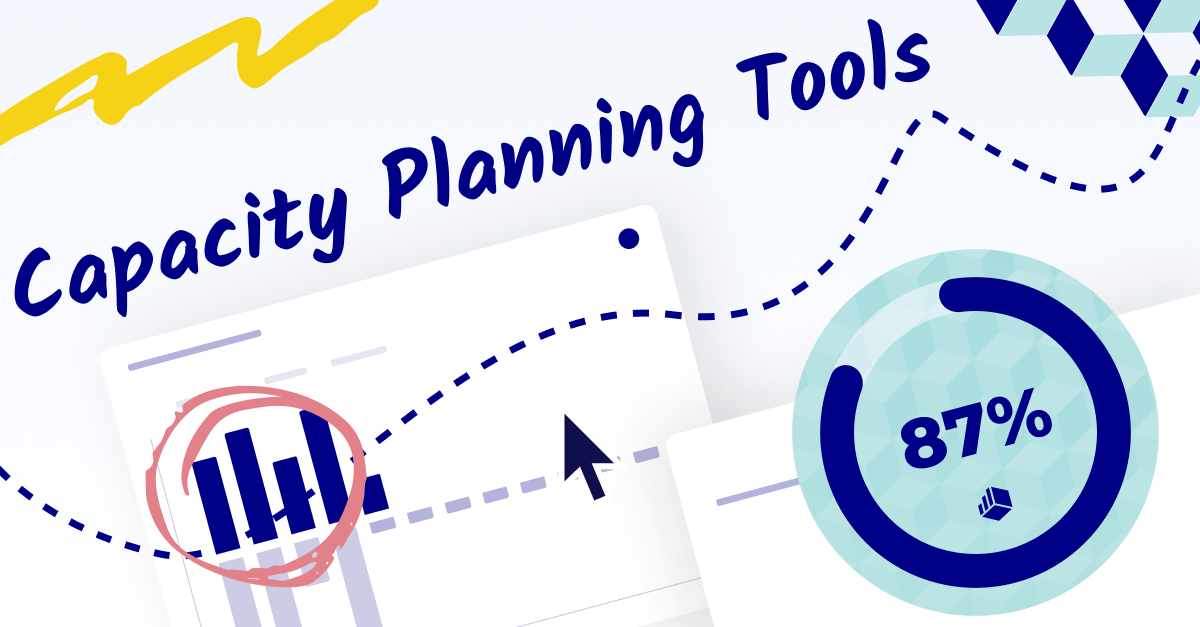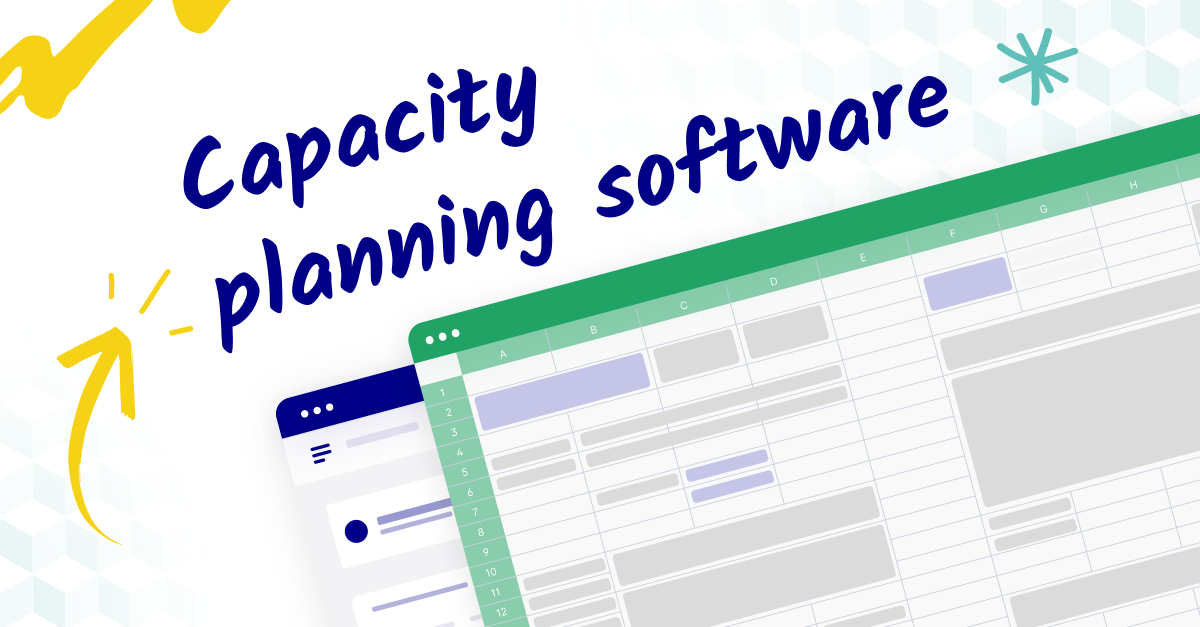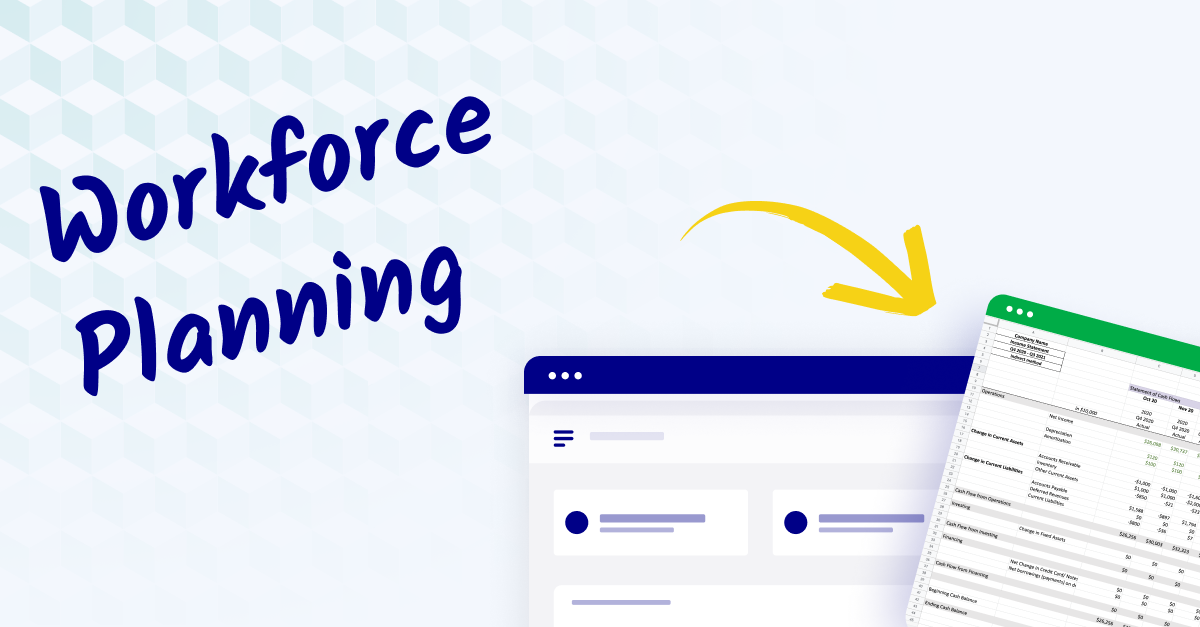What is capacity planning?
Capacity planning is a strategic process for considering current and future projects and determining whether your team can carry out that work in the required timeframe. It encompasses elements of resource management, helping you identify bottlenecks, mitigate risk, and know when to scale.
Capacity planning balances the size of your team and the amount of work they need to do.
Too much capacity will reduce profits and slow growth. And too little will be unsustainable, so you’ll need to adjust workload or capacity, which eats into your profit margins. Here, demand planning becomes crucial to ensure that you are adequately prepared for future requirements.
Capacity planning is greatly facilitated by the use of specialized capacity planning software, which helps businesses streamline their planning processes and make data-driven decisions.
Let’s look a little deeper into the topic.
The three capacity planning strategies to maximize available resources
There are three common capacity planning strategies: lead, lag, and match, which are essential components of strategic planning.
There's no clear winner of the different capacity planning strategies. Your own style determines the most effective capacity planning process for you.
That said, FP&A teams should focus on workforce capacity planning. This ensures the company has enough people and hours to complete the work. Other types of capacity planning focus on tools and product availability. Many businesses opt for capacity planning tools to streamline the process and make data-driven decisions.
Lag strategy
.png?width=600&height=314&name=Lag%20Strategy%20(1).png)
The reactive approach. You plan to have the production capacity to meet actual demand.
So you only increase capacity when there’s an increase in demand. This is also called 'lag strategy planning.'
Lead strategy
.png?width=600&height=314&name=Lead%20Strategy%20(1).png)
The proactive approach. You plan to have the resource capacity to meet your forecasted demand.
This means you increase capacity to match the expected increase in demand. This is sometimes called 'lead capacity planning.'
Match strategy
.png?width=600&height=314&name=Match%20Strategy%20(1).png)
The middle ground between lag and lead strategies. You do capacity planning more frequently to monitor actual demand, forecasted demand, and market shifts.
So you can make incremental capacity changes and be more flexible to meet demand. This approach is also called 'match strategy planning.'
What about resource capacity planning?
You'll sometimes see—in capacity planning tools or other material—the phrase "resource capacity planning."
This is the best of both worlds: capacity planning meets resource planning.
But good capacity planning should include resource planning anyway. Resource capacity planning is made more efficient with the help of dedicated resource capacity planning software. This software enables businesses to allocate resources effectively, considering factors like skills and availability.
A simple capacity planning process
HR or People Ops teams will already have their favorite capacity planning strategy.
But your FP&A team might not have an opinion on workforce resource planning. Working together with your people team means you'll be able to create more accurate budgets and forecasts.
Here’s the step-by-step resource planning process:
1. Calculate available capacity for cost-effective resource management
Start by looking at your team and working out what they can get done during business hours. But don’t forget: not every hour is available for projects or deliverable work.
Meetings, emails, Slack messages, and general admin tasks interrupt your team’s time. Plus, people take vacations or have sick days, which also reduces team capacity.
2. Assess staff skills to get a more detailed view of team capacity
Not every team member will be able to do every task. So it’s not just employee availability that you need to consider. Look at the available skills across the team and the varying levels of experience.
Take these into consideration to calculate how much capacity you actually have.
3. Review upcoming work to understand capacity requirements
Your next step is to determine what resources you’ll need for your upcoming projects.
There are a couple of different ways to do this:
If you use a lag strategy, look at the projects you’ve committed to. Then, work out the resources (both team availability and skills) you’ll need to deliver them.
And if you use a lead strategy, look at future project forecasts and estimate the resources you’ll need to complete them.
Either way, you have to ensure you're allocating enough resources to meet customer demand. Your capacity planning strategy should always lead to the business's end goals.
4. Prioritize projects to understand how production capacity will change over time
Your team won’t work on all their projects at once. Figuring out what you’ll do and when will help with your resource planning estimations. Ask yourself:
Which projects are essential, and which are just nice to have?
Which are urgent, and which can wait until next quarter?
If you find you have excess capacity, teams can always begin projects ahead of plan.
5. Document known risks to work out what could affect your capacity
What could dramatically reduce your team’s capacity?
Example risks could include changes within the company, such as key employees leaving or budget cuts.
They could also include external challenges. For example, pandemics, supply chain issues, or adverse weather like hurricanes or flooding all affect your team's ability to meet demand.
6. Make plans for handling capacity and demand misalignment
In an ideal world, you’ll have perfect project management: a balance between the work you need to do and your team’s production capacity.
But we all know how reality works.
Have a backup plan for how you’ll adapt your resource management strategy to changing team capacity or workloads.
This is where your strategic planning chops come in handy.
You’ll need separate plans to manage excess capacity and capacity lack.

The benefits of effective capacity planning
Capacity planning involves budgeting, resources, and project management—crucial for running any business.
Here are four specific benefits of capacity planning for CFOs and their teams:
Finance teams can budget more intelligently
Capacity planning forces you to check the assumptions you and other team members make during the budgeting process. It helps you create budgets grounded in reality, rather than based on assumptions.
Let’s look at an example:
Your head of sales needs to double the revenue generated by their team in the next year.
What does that mean for their team and budget?
Well, it depends if that target’s realistic, based on the team’s current capacity. Take a look at the sales team’s capacity utilization to figure it out.
If the team already operates at 85% capacity, the only way to hit their targets is by increasing headcount. That will affect the sales department's budget (and your hiring plans).
So now you understand—if finance leaders are involved with capacity planning, FP&A teams can budget more intelligently. As a result, you can create realistic budgets for different departments and projects.
Avoid the stress of under-staffing
Strategic capacity planning helps you anticipate the team size needed to achieve the company’s growth targets. You know whether to speed up or slow down hiring accordingly.
Under-staffing is a serious challenge for businesses. If teams are short-staffed, it leads to high stress levels, burnout, and increased turnover.
And research has shown that.
.png?width=600&height=314&name=Burnout%20(1).png)
A Deloitte study found that 77% of full-time workers have experienced employee burnout, and 42% have left a job because of it. They identified several causes of burnout, including:
- Unrealistic deadlines
- Consistently working long hours and weekends.
Both point to poor capacity planning, and the team suffers as a result.
But it gets worse.
As people leave, it further reduces your team’s capacity and makes things worse for the rest of the company. Then, it takes time to find and onboard new hires—sometimes months. And all that time, the team is still understaffed and burnout levels are rising.
All it takes is a few key departures to make previously-manageable workloads feel overwhelming.
Match skill needs with team capabilities
According to PWC, CFOs know how important it is to get the right talent into the company. Capacity planning gives you visibility into the skills you have on the team—and what you’re missing.
Look at it this way:
CFOs need to be involved in capacity planning so they understand the skills required to meet the company’s upcoming workload.
It will help them identify skills gaps and hiring shortages before they become a problem. Then, they can address those shortages with targeted hires, and ensure the company has the budget available to recruit people with the necessary experience levels.
Make more accurate growth predictions and plans
Your financial forecasts help you work out which departments will have the biggest impact on company growth in the next 12-24 months. Then, capacity planning ensures you’re correctly investing in those teams.
If you use a rolling forecast, you can revise your growth forecasts as team capacity changes. This will mean your predictions better align with the current state of the business.
As a result, capacity planning turns your FP&A team into a forward-looking department. They can focus on maximizing business effectiveness, rather than traditional finance-related tasks. This shift is vital for strategic financial management, ensuring that the finance department contributes directly to the company’s success.
Why does that matter?
Well, according to IBM, “freeing up the time to work on strategic challenges is an issue for finance organizations.” This is a common challenge in financial planning and analysis, where teams are often bogged down by manual processes and outdated systems.
.png?width=600&height=314&name=Kristina%20DelValle%20Cube%20handles%20the%20majority%20of%20the%20work%20for%20me%20(1).png)
This is something we see all too often. For example, Kristina Delvalle, VP of Finance at 1Rockwell, was spending so much time closing the books and preparing KPIs.
Her role was responsive (instead of proactive) until she started using Cube. Now, creating different scenarios takes Kristina and her team a fraction of the time it used to. She has accurate, clean data that helps her to make better strategic decisions.
In other words, involving your finance team in capacity planning means they can make more accurate growth forecasts. This strengthens their reputation as a key strategic partner in the business, aligning with the best practices in financial planning and analysis.

Where FP&A and capacity planning intersect
Capacity planning feeds into the company’s growth plans and forecasts. More resources mean more production capacity, which improves your team's ability to meet demand and drive revenue.
This is why FP&A teams need to understand how workforce capacity planning ties into their priorities.
Capability analysis helps you plan to improve over time
Capability analysis is the process of understanding your team’s skills (their capabilities). Capability building is the next stage of the process. It involves increasing skills over time through strategic hiring and team development.
The skills you have available affect your team's capacity for different project types. CFOs and finance teams can use capacity analysis when mapping out growth plans to improve their rolling forecasts.
But why does it matter?
For service-based businesses, it’s essential. By building capabilities across your team, you can deliver more complex work, charge more for it, and increase revenue.
And for product businesses, capability analysis guides your hiring plans and budgets. Higher skills and experience levels also mean you can work more efficiently and increase margins—so it’s not just beneficial for service businesses.
Finance teams set budgets for skills and talent development
Skills and talent development are important considerations during the capacity planning process. It’s crucial for predicting how company capacity will increase over time as the existing team builds its skills and experience.
Here’s an example:
You have lots of junior employees and plan to invest heavily in training and development. This means the team’s capabilities will look very different by Q3 compared with Q1. So the work you can do will be very different too.
So finance teams should be involved in conversations around developing skills and talent—especially regarding training needs. Otherwise, they’ll assume the team’s skills will remain stable, and underestimate your growth potential.
And that’s not the only reason.
Team training is a significant item in your budget, so it can’t just be perceived as an HR or people ops project. Your finance team must know what’s needed, so they can take it into account when creating company and department budgets.
Headcount planning helps you predict future capacity
Headcount planning is the process of planning and prioritizing hiring and team growth so that you keep up with the changing needs of the business. It shouldn’t be left to the COO or people ops teams. Instead, it should be a core focus for finance teams.
Here’s why:
According to PWC, “55% of CFOs consider talent acquisition and retention a serious business risk” in 2022. So CFOs and finance teams need to be involved in headcount planning to factor it into their budgets, risk analysis, and forecasts.
In other words, FP&A must understand how the company needs to grow to achieve its growth goals.
%20(1).png?width=600&height=314&name=55%25%20of%20CFOs%20consider%20talent%20acquisition%20and%20retention%20a%20serious%20business%20risk%20(source_%20PwC)%20(1).png)
For example:
If the company needs to generate an extra $5M in revenue next year, how many additional sales reps do you need to meet that goal? And then how many new hires in your marketing team, to generate enough leads for the sales pipeline?
As with skills development and capability analysis, it all ties back to your budgets.
Capacity planning builds resilience in the business
At its heart, capacity planning is all about increasing the company’s resilience. Which is also a priority for CFOs and their teams.
CFOs can use insights about capacity and the team's capabilities during scenario planning. They can consider the team as well as revenue, so they have a complete picture of the company's financial and operational health.
The benefit?
It helps to build resilience in the business.
According to Deloitte, FP&A teams can “run more dynamic scenario testing cycles, and also create a more integrated forecast and planning capability to inform business decisions.”
Think about it this way. If your finance team understands the company’s capabilities, they can:
- Diversify skill sets across departments
- Create additional capacity through strategic hiring
- And make best and worst-case scenario plans to prepare for capacity or demand changes.
CFOs make data-informed decisions with capacity planning
Capacity planning gives FP&A teams the data they need to guide the decision-making process for the company. It lets them see the big picture.
In other words, CFOs get deeper insights into the company from conversations about capacity, team, skills, and headcount. As a result, they can offer more nuanced advice to the CEO.
Here’s why that matters:
When the CEO makes plans and sets growth targets for the company, they rely on the CFO to guide their decisions.
And how do CFOs get the insights they need to do that? By being involved in those conversations about the team and its capacity.
They need to be able to explain how the CEO’s plans will affect the company’s financial position, and how the team needs to adapt to deliver on those plans.
But how does the CFO get those insights quickly and easily?
Thankfully, it’s not as tricky as you’d think. Many companies invest in software to automate or streamline the capacity planning process. It gives them quicker access to the data they need to understand and forecast team capacity.
And according to our CEO, Christina Ross, that’s a worthwhile investment.
In a recent interview with CFODive, she explained that automation is “helping those finance teams be more strategic and be more effective in their roles, helping the business move forward in a more effective way.”
.png?width=600&height=314&name=Christina%20Ross%20on%20automation%20and%20finance%20teams%20(1).png)
Best practices for capacity planning
Established capacity planning practices hold significant importance for CFOs aiming to maximize resource utilization, streamline demand fulfillment, and attain strategic objectives. Here are some key best practices for effective capacity planning:
Cross-Functional Collaboration: Encourage collaboration between departments like operations, sales, marketing, and finance. This ensures alignment between capacity plans and business goals, as well as a comprehensive understanding of demand drivers.
Risk Management: Identify potential risks that could disrupt capacity planning, such as supply chain disruptions or economic downturns. Develop contingency plans to mitigate these risks and maintain flexibility in your capacity plans.
Technology Adoption: Leverage specialized capacity planning software and tools to streamline the process, enhance data accuracy, and facilitate real-time monitoring. These tools can automate data collection and analysis, improving overall efficiency.
Regular Demand Forecasting: Develop robust demand forecasting models that consider historical data, market trends, and seasonality. Periodically update these forecasts to reflect changing market conditions.
Scenario-Based Preparedness: Develop a comprehensive scenario analysis framework that anticipates diverse "what-if" scenarios. This proactive approach allows CFOs to assess the impact of demand fluctuations, resource constraints, or external disruptions and fine-tune capacity plans accordingly.
It's essential to adopt a proactive, rather than reactive, approach to capacity planning. Waiting until resources are strained can lead to costly downtime and customer dissatisfaction.
Five capacity planning metrics your finance team needs to know
There are lots of different metrics that relate to capacity planning. We’ve picked out five of the most important ones for finance teams to understand.
1. Capacity utilization rate
Capacity utilization is the percentage of your team’s work hours occupied by deliverable work. Tracking capacity utilization helps ensure you have enough team members to meet deadlines.
Additionally, it enables you to identify capacity gaps as they appear, so you can adapt as needed.
To measure capacity utilization, use the following formula:
(Planned capacity / Total capacity) x 100 = Capacity utilization %
%20(1).png?width=600&height=338&name=Capacity%20Utilization%20Rate%20(2)%20(1).png)
As a simple example, you have a 10-person marketing team working 40-hour weeks. You have an upcoming project that will require eight people on that team to work on it full-time. So the calculation will be as follows:
(320 / 400) x 100 = 80% capacity utilization of your marketing team for that project.
Note: It may seem counter-intuitive, but you shouldn’t aim for a 100% utilization rate. At 100%, your entire team is working at maximum capacity. Any extra tasks push them over capacity, leading to high stress levels and burnout.
2. Employee turnover rate
Employee turnover rate is the percentage of employees who leave your company during a certain period. It includes resignations, dismissals, and retirements.
Tracking employee turnover rate helps you understand how team capacity will likely change over time. This means you can plan your hiring campaigns to maintain capacity. You can plan based on what your team capacity is likely to be—not just what it is today.
.png?width=600&height=338&name=Employee%20Turnover%20Rate%20(1).png)
To measure the employee turnover rate, use the following calculation:
(Number of employees who leave during a specific timeframe / Average number of employees during that timeframe) x 100 = Employee turnover rate.
3. Time to full productivity
This measures how long it takes new employees to reach full productivity levels. It includes their onboarding period, time learning new systems and processes, and training.
But how does this relate to capacity planning?
Think of it this way. When existing employees leave, it takes time to hire replacements. And even if you’re back to the same number of employees, your capacity is still reduced while your new team member ramps up within the business.
.png?width=600&height=314&name=Time%20to%20full%20productivity%20(1).png)
Time to full productivity is harder to measure than the other metrics in this article.
First, you’ll need to have clear goals or KPIs that show when an employee is achieving “full productivity”. These will vary between roles, departments, and seniority levels.
Then, track how long it takes for new hires to achieve those KPIs.
This gives you that employee’s time to productivity. By tracking it over time, you’ll get an idea of how it varies across departments, roles, or employee types.
4. Revenue per employee
Revenue per employee calculates how much revenue an employee generates for the company. Crucially, it’s an average for all employees, not a specific measure of an individual’s contribution.
It’s an important metric to consider when capacity planning as it ties into the company’s hiring plans.
%20(1).png?width=600&height=338&name=Revenue%20per%20employee%20(2)%20(1).png)
For example, you’re planning to hire 20 new employees. How much extra revenue do you need to generate, to maintain a steady revenue per employee?
Here’s the formula for calculating revenue per employee:
Total revenue in a given timeframe / Total number of employees = Revenue per employee.
5. Rule of 40
Rule of 40 is a quick way to identify your company’s overall health by looking at its growth rate and profit margin. It helps you understand whether the company is growing sustainably or if you’re over-prioritizing either growth or profit.
Tracking Rule of 40 enables you to balance the two. It helps you understand if you need to take on more work or hire more aggressively to meet your growth goals.
.svg)
To calculate the Rule of 40, use the following formula:
Growth Rate (%) + Profitability Margin (%) = Rule of 40
We’ve put together a detailed explainer of the Rule of 40, including how to calculate each part of the formula. Read the full article to understand what it is and why it’s so important—especially for SaaS companies.
Final thoughts on capacity planning
Now you know all about effective capacity planning and resource planning.
No matter which strategy you've opted for, Cube is here to simplify your workflow. We seamlessly bridge your source systems with your trusted Excel spreadsheets, eliminating the hassles of data preparation and reconciliation concerns.
Cube empowers CFOs and their FP&A teams to swiftly and confidently analyze, plan, and collaborate.
Ready to supercharge your financial planning? Schedule a demo today and experience the difference firsthand.



.png)





.png?width=600&height=314&name=Lag%20Strategy%20(1).png)
.png?width=600&height=314&name=Lead%20Strategy%20(1).png)
.png?width=600&height=314&name=Match%20Strategy%20(1).png)

.png?width=600&height=314&name=Burnout%20(1).png)
.png?width=600&height=314&name=Kristina%20DelValle%20Cube%20handles%20the%20majority%20of%20the%20work%20for%20me%20(1).png)
%20(1).png?width=600&height=314&name=55%25%20of%20CFOs%20consider%20talent%20acquisition%20and%20retention%20a%20serious%20business%20risk%20(source_%20PwC)%20(1).png)
.png?width=600&height=314&name=Christina%20Ross%20on%20automation%20and%20finance%20teams%20(1).png)
%20(1).png?width=600&height=338&name=Capacity%20Utilization%20Rate%20(2)%20(1).png)
.png?width=600&height=338&name=Employee%20Turnover%20Rate%20(1).png)
.png?width=600&height=314&name=Time%20to%20full%20productivity%20(1).png)
%20(1).png?width=600&height=338&name=Revenue%20per%20employee%20(2)%20(1).png)



